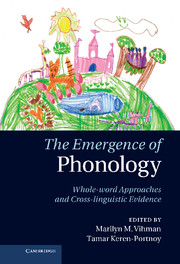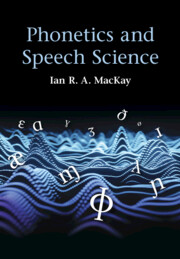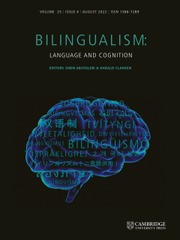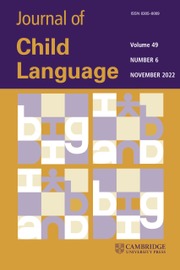The Emergence of Phonology
How well have classic ideas on whole-word phonology stood the test of time? Waterson claimed that each child has a system of their own; Ferguson and Farwell emphasized the relative accuracy of first words; Menn noted the occurrence of regression and the emergence of phonological systematicity. This volume brings together classic texts such as these with current data-rich studies of British and American English, Arabic, Brazilian Portuguese, Finnish, French, Japanese, Polish and Spanish. This combination of classic and contemporary work from the last thirty years presents the reader with cutting-edge perspectives on child language by linking historical approaches with current ideas such as exemplar theory and usage-based phonology, and contrasting state-of-the-art perspectives from developmental psychology and linguistics. This is a valuable resource for cognitive scientists, developmentalists, linguists, psychologists, speech scientists and therapists interested in understanding how children begin to use language without the benefit of language-specific innate knowledge.
- Provides the classic studies in the 'whole-word' or 'usage-based' approach to child phonology alongside new perspectives, so several key studies are available under one cover to students, teachers and researchers
- Updates classic approaches by linking them with current ideas such as exemplar theory
- Expands the usual Anglocentric approach, by making a wide range of data available from eight languages
Reviews & endorsements
'The field of language acquisition - and indeed, theoretical linguistics itself - has seen a dramatic shift in views about how sounds, words, and meanings are acquired. The assumption that segments or phonemes were the [foundation] to learning (often with the accompanying assumption that these units were innately specified) has been challenged by findings that support the usage-based 'whole word' approach presented here. Although the sea change is recent, the idea itself has important antecedents dating back at least to the 1970s. This volume is a wonderful collection of papers. Some are foundational classics. Other, more recent works, reflect new insights into the role of exemplars, templates, and schema in the acquisition of phonology. Taken together, the collection presents an account of phonological development that is both cutting edge and compelling.' Jeffrey L. Elman, University of California, San Diego
'Brings together classic papers and state-of-the-art research to provide a compelling account of phonological development. The breadth of the cross-linguistic evidence presented here is particularly welcome and impressive. This book forms a significant contribution to the literature which will be appreciated by a wide readership.' Sara Howard, University of Sheffield
'The Emergence of Phonology is a collection of descriptive papers for linguists researching early phonological development in children. The studies presented here provide detailed discussion and analysis of the early stage of language acquisition in children learning different languages. Based on fieldwork and personal data collection from subjects, the authors successfully describe the individual factors as well as general implications of first language acquisition.' Anett Réka Garami, LINGUIST List
Product details
November 2013Hardback
9780521762342
532 pages
229 × 152 × 29 mm
0.88kg
39 b/w illus. 70 tables
Available
Table of Contents
- 1. Introduction Marilyn M. Vihman and Tamar Keren-Portnoy
- Part I. The Current Framework:
- 2. Phonological development: toward a 'radical' templatic phonology Marilyn M. Vihman and William Croft
- Part II. Setting Papers:
- 3. Child phonology: a prosodic view Natalie Waterson
- 4. Words and sounds in early language acquisition Charles A. Ferguson and Carol B. Farwell
- 5. Developmental reorganization of phonology: a hierarchy of basic units of acquisition Marlys A. Macken
- 6. Development of articulatory, phonetic, and phonological capabilities Lise Menn
- Part III. Cross-Linguistic Studies:
- 7. One idiosyncratic strategy in the acquisition of phonology T. M. S. Priestly
- 8. Phonological reorganization: a case study Marilyn M. Vihman and Shelley L. Velleman
- 9. How abstract is child phonology? Towards an integration of linguistic and psychological approaches Marilyn M. Vihman, Shelley L. Velleman and Lorraine McCune
- 10. Beyond early words: word template development in Brazilian Portuguese Daniela Oliveira-Guimarães
- 11. Templates in French Sophie Wauquier and Naomi Yamaguchi
- 12. The acquisition of consonant clusters in Polish: a case study Marta Szreder
- 13. Geminate template: a model for first Finnish words Tuula Savinainen-Makkonen
- 14. Influence of geminate structure on early Arabic templatic patterns Ghada Khattab and Jalal Al-Tamimi
- 15. Lexical frequency effects on phonological development: the case of word production in Japanese Mitsuhiko Ota
- Part IV. Perspectives and Challenges:
- 16. A view from developmental psychology Lorraine McCune
- 17. Challenges to theories, charges to a model: the linked-attractor model of phonological development Lise Menn, Ellen Schmidt and Brent Nicholas.








